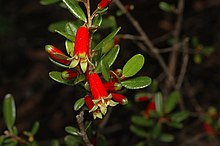Nematolepis phebalioides
Nematolepis phebalioides, is a small, spreading shrub with ascending branches covered in scales, smooth, glossy leaves and pendulous, red tubular flowers with yellow or green tips, flowering from March to December. It is endemic to Western Australia.
| Nematolepis phebalioides | |
|---|---|
 | |
| Scientific classification | |
| Kingdom: | |
| (unranked): | |
| (unranked): | |
| (unranked): | |
| Order: | |
| Family: | |
| Genus: | |
| Species: | N. phebalioides |
| Binomial name | |
| Nematolepis phebalioides Turcz.[1] | |
Description
Nematolepis phebalioides is an upright shrub to 3 m (9.8 ft) high. The leaves are on ascending branches on a short petiole, elliptic to broadly elliptic shaped, about 15 mm (0.59 in) long, leathery, smooth, glossy on the upper surface, grey scales on underside and rounded at the apex. The flowers are borne singly in leaf axils, corolla tubular about 15 mm (0.59 in) spreading, pendulous, on a pedicel about 3 mm (0.12 in) long with small bracts, boat-shaped and close to the base of the calyx. The sepals are triangular or rounded, about 1.5 mm (0.059 in) long, smooth or with occasional scales. The red, smooth, bell-shaped floral tube is 10–15 mm (0.39–0.59 in) long, 5 petalled with short yellow or green lobes and yellow stamens. The dry fruit capsule is about 5 mm (0.20 in) high, square, finely wrinkled and ending in a short triangular point. Flowering occurs sporadically throughout the year, mostly in winter.[2][3][4]
Taxonomy
This species was first formally described by Nicolai Turczaninow in 1852 and the description was published in Bulletin de la Societe Imperiale des Naturalistes de Moscou.[5][6]
Distribution and habitat
Nematolepis phebalioides is endemic to the south coast of Western Australia from Dumbleyung and east to Israelite Bay. It grows in loam, clay, coastal limestone, sand dunes and on lateritic hills and in mallee thickets.[2][4]
References
- "Nematolepis phebalioides". Australian Plant Census. Retrieved 28 July 2020.
- Wilson, Paul G. "Nematolepis phebalioides". Flora of Australia. Australian Biological Resources Study, Department of Agriculture, Water and the Environment: Canberra. Retrieved 1 August 2020.
- Mullins, Effie. "Nematolepis phebalioides". Growing Australian Plants. Australian National Botanic Gardens.
- Wilson, Paul G. (1999). Flora of Australia-Volume 26 Meliaceae, Rutaceae, Zygophyllaceae. Canberra/Melbourne: ABRS-Department of Environment & Heritage. p. 448. ISBN 9780643109551.
- "Nematolepis phebalioides". Australian Plant Name Index. Retrieved 5 August 2020.
- Turczaninow, Nicolai (1852). "Decas septima generum adhuc non descriptorum adjectis descriptionibus nonnullarum specierum". Bulletin de la Societe Imperiale des Naturalistes de Moscou. 25 (3): 158. Retrieved 6 August 2020.